From the Holiday 08 issue.
Our mission is simple: to renovate a century-old Victorian in downtown Boulder in an energy-stingy, chemical-free, low-water manner.
Why? because we’ve got to minimize our negative impact, and help the market make eco-responsible living affordable for those without trust funds. Why? Because our earth is bearing a huge population that likes to consume—but is less happy (studies show) than we were 50 years ago, when we consumed half as much.
Because, simply, I want to be happy—and full-on happiness includes not being selfish at the expense of others.
And so I don’t mind that I haven’t had light fixtures upstairs for two years, because I’m slowly buying energy star fixtures that’ll save me some dough and us some electricity. And so my clawfoot tub is refinished, salvaged from a Denver hotel. And so I ask for low-or-no-V.O.C paints, and I use American Clay, so that my puppy, my guests and myself can breathe clean indoor air. And so I sold my five year old fridge—the most energy intensive fixture in the home, apparently—to a landlord pal o’ mine so I could buy a smaller, new energy star one. And so my roof will be made of recycled, recyclable metal. And so I insulated my attic with nontoxic fire retarding newspaper pulp, so my heat (oil) doesn’t go through the roof. And so I shouldered a big mortgage so I could live—and bike everyday—downtown (it also happens that buying a home in a strong community with local shops and parks and schools is the best protection against a housing boom gone bust). And so my furniture is off Craigslist, or bought green or at least at a local, independent business that helps keep dollars in my community (instead of sending it off to already-fat cats). And so my landscaping is low-water (and low-maintenance), my hot tub is set on low and cleaned with nontoxics, my graywater feeds my non-lawn, my house half-powered by solar and my laundry is hang-dried.
Funny thing is, this mindfulness stuff ain’t about being righteous. It’s actually fun to continually improve, to think about everything I buy, instead of (as I did only a few years back) driving home big bags of cheap stuff (from China) from Targét that I hadn’t known I wanted. And so it is that when it came to adorning my low-V.O.C. and/or clay walls, I wanted something dignified yet wild, classic yet green. And so I turned to Kanjuro Shibata Sensei, my childhood kyudo teacher, and Jason McPhilipps, a local craftsman.
All photos by Timmy D’Antonio for elephantjournal.com:
[galleria thumb_w=120 thumb_h=90 thumbnail=”bottom” navigation=’none’ ]On a limited budget, is it possible to go green in an elegant and affordable manner? It’s a cute question, but one that, day to day, necessitates finding creative solutions. So when I wanted art for my walls, I searched out the most meaningful art I know—and the greenest craftsman to offer the art in a context of elegance.
The Calligraphies
Kanjuro Shibata Sensei XX is 20th in the line of bowmakers to the Emperor of Japan. Born over 80 years ago, you could call him ‘the Last Samurai.’ And yet despite his frail frame, he still teaches kyudo, “moving meditation” archery, leading a teaching schedule that college kids might find daunting.
He also happens to be a calligraphy master. And so it is that, in seeking to create a dignified, uplifted space created in harmony with our ravished planet, went to Sensei and commissioned four calligraphies with meaning, that had the pleasant side effect of supporting his work in some small way.
>> From Carolyn Kanjuro: “Sensei grinds his own ink. The paper is high-quality, handmade from Japan. Each calligraphy is different. He painstakingly cuts the paper himself. He did do the ones today with you specifically in mind, but is giving you a choice as to which one you would like. Sensei’s style is to follow the ‘chi’ of the moment when he does these. He does not generally do ‘made to order.’ He’s an artist in that regard: when he is holding someone in mind, what comes to him comes, rather than that they dictate their wishes. It’s part of the magic and teaching of the whole thing. He doesn’t do nearly as many these days as he used to—they take a lot of energy and concentration.”
Sensei executed two calligraphies, representing some of his core teachings:
>> Wa o mote totouhito nasu (I call this one his ‘United Nations of calligraphies’). It basically means “high quality people bring peace to the world.” Another way he translates this is: “When we bring our high quality hearts together, and no one is higher or lower, we create a peaceful world.” It’s a very big and beautiful idea.
> Fu Rin Ka Zan. This means: “Wind, Tree, Fire, Mountain.” Wind, like gossip, moves at high speed. When it hits the pine tree, a lone practitioner in meditation, it goes quiet. Inside, the fire of determination burns. With this, the mountain never moves; there is stability in one’s practice and the community.” This is one Chögyam Trungpa Rinpoche asked Sensei to make for the benefit the Shambhala Buddhist community.



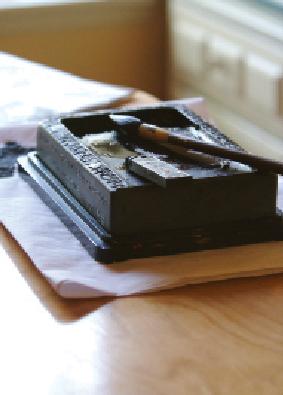
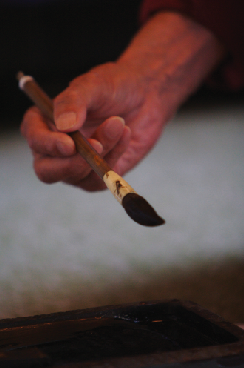
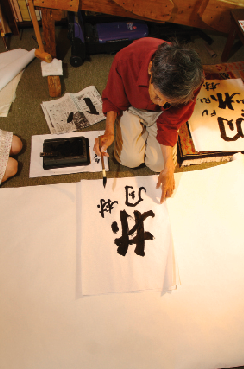
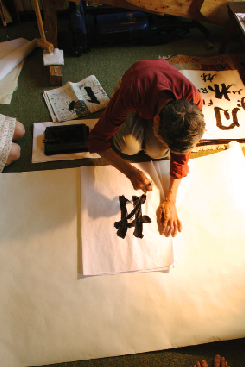
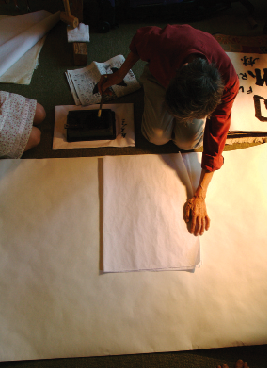
The Frames
>> From Jason McPhillips, artist and craftsman: “I sought to create a simple, spacious presentation for Kanjuro Shibata’s calligraphies. Waylon [ele’s ed-in-chief] and I ventured to ReSource and spent the morning playing with potential materials. Working with reclaimed materials, it’s always tricky to find what works—and enough of it to do the job. Frequently one finds the perfect moulding, only to find that you need another 20 feet of it. So it’s back to the wandering and digging and musing until coincidence and insight intersect. I wanted to create subtle frames, which would function broadly from a distance but hold some interest close-up as well. I ended up settling on two types of reclaimed wood—both tongue and groove materials. The Groove supplied a convenient Rabet for the frame, once I worked half of it down with a chisel and hand plane. The width was nearly ideal, generous enough to enclose the pieces and set them apart from the wall.
Wood frequently has more personality than you’d like. It does all kinds of things you wish it wouldn’t. Each piece is a little different, in spite of the sawmill’s efforts at consistency. Reclaimed wood has even more personality, and working with it requires equal parts inspiration and patience. By embracing happenstance and remaining present, “flaws” become “opportunities.” Creating these frames required me to perfect a new approach to the classic mitre joint, as well as devising a few clamping techniques.
“I created these frames for Sensei’s calligraphy in an effort to create the greenest picture frames possible. Everything that went into these frames was either reclaimed, reused, recycled, or renewable:
>> Reclaimed Lumber (From Resource): Tongue and Groove Oak Flooring and Tongue and Groove Knotty-Pine Paneling
>> Misc. Pine Scraps
>> 100% Cotton-Rag Mat Boards “Rag” is a papermaker’s term dating back to the 15th century when cotton rags and trimmings were the principal raw materials used for papermaking. The term continues to describe papers and boards made of 100% cotton fiber. The Gutenberg Bible, the drawings of Renaissance masters, Shakespeare’s first folio, the U.S. Constitution, and the Bill of Rights still exist today because they were printed or penned on cotton fiber paper. Cotton fiber paper is specified for currency, stock certificates and government documents because of its permanence. Cotton makes the finest type of paper and mat boards because it is the purest form of natural cellulose. Rag is strong, requires less processing, has a history of performance and it is an annually renewable resource, making it better for our planet. Both Rag and Rag “100” are 100% Cotton Fiber.
>> Eco-Glass from Eco-Display Systems. An alternative to Plexi-glass which is made from 100% recycled drink bottles
>> Finish: First, I “Ebonized” the wood with many thin coats of waste “process black” ink from an archival (gicleé) print shop (call your local print shops). Next, I sealed the wood with shellac: a natural, mostly non-toxic and renewable finish and thinned it with alcohol—the harshest solvent I used! Once dry, shellac is non-toxic, even used in coating pharmaceuticals. It is not totally cruelty free—it is secreted by an insect. Next, the Chinese Vermilion accents were mixed from oil paint using Non-toxic pigments, true Chinese Vermilion is one of the most expensive colors out there, and most toxic. Oil paint is made from pigment and linseed oil, otherwise known as “flax-oil.” Finally, for the satiny sheen I used a mixture of Beeswax and Carnuba Wax.
>> Cost: $2.20/square inch. A custom 11 x 14 frame with mat, glass, and mounting would cost around $340. Certainly not cheap compared to a mass-produced, conventionally toxic, made-in-unfair-laborland product. I’m not sure what a 21 1/2” x 38 7/8” custom frame (with hand-finishing), mat, museum mount and glass ensemble would cost at a local frame shop, but it would probably cost about the same!
>> Jason McPhillips, a professional artist, was awarded the Charles X. Carlson Landscape Painting Residency in late ‘99, giving him three months of painting in rural Pennsylvania. His host showed him some beautiful old hand planes, and invited him to experiment with them. It was a wet Summer in Lancaster, and every rainy day found Jason in the basement woodshop, planing away at cheap lengths of pine, contemplating the perfect mitre joint and pulling splinters from his fingers. He has been making his own frames ever since. Jason teaches drawing at the Colorado Academy of Art.



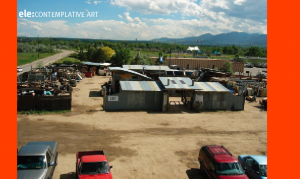








Read 4 comments and reply